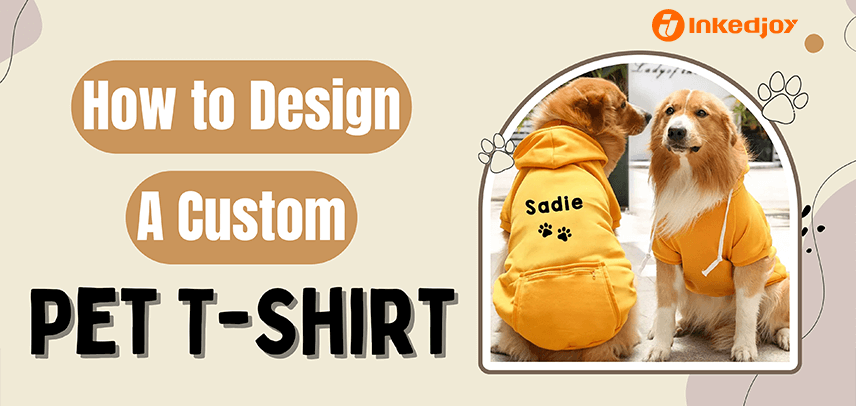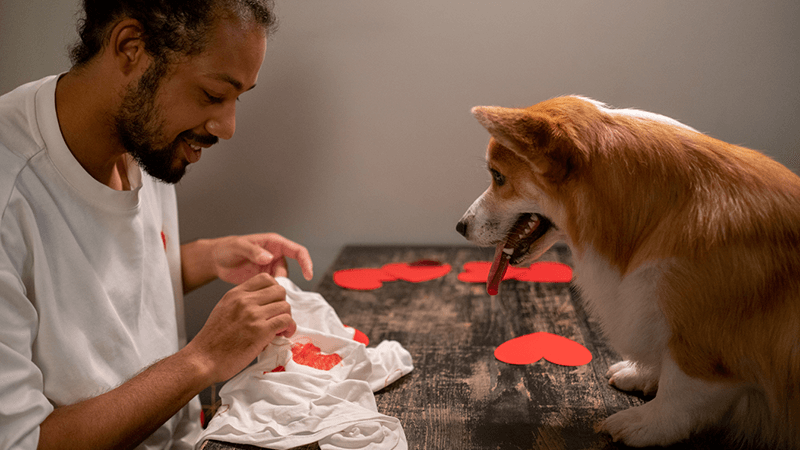
How to Design a Custom Pet T-Shirt
Creating a custom pet t-shirt is art and animal love mixed together in one ultra-adorable package. You can design pet apparel for everyday wear, parties, or holiday parties, making it simple for pet owners to showcase their pet's personality while keeping them comfortable and stylish. This step-by-step guide will walk you through the entire design process.
Getting Started: Essential Considerations
Before diving into the creative process, several fundamental factors require attention. Pet comfort stands as the top priority when designing any wearable item. Consider the pet's size, breed characteristics, and typical activity levels. Active dogs need breathable fabrics and flexible fits, while indoor cats might prefer softer, lighter materials.
The design purpose also influences material choices and style decisions. A costume for a single event differs significantly from everyday wear meant for regular use. Weather conditions play a crucial role too – summer designs need cooling properties, while winter pieces require warmth without bulk.
Measuring for the Perfect Fit
Measuring accurately is essential in creating quality pet apparel. The most vital measurements include chest girth at widest point, neck girth, and the length of the back from the neck to the base of the tail.
Additional measurements help to make a closer fit: shoulder measurement, leg measurement for items with four legs, and belly measurement for things that are more snugly fitted. Take all the measurements when the pet is standing naturally, never using tight or loose tape. Use measurements in inches and centimeters to match production requirements.
Think about growth patterns for younger animals. Kittens and puppies grow quickly, so it is economically sensible to design with some adjustability or to order larger sizes.
Fabric Selection and Material Properties
Fabric choice affects design comfort and flexibility. Blends of cotton are breathable and soft and are suitable for sensitive skin. Moisture-wicking materials are good for active, outdoor-playing pets or those with a high activity level.
Stretch fabrics allow more movement but can restrict some print methods. Polyester holds colors well and won't fade fast, while natural fibers offer amazing comfort but can have special care instructions.
Avoid coarse-textured, very thick, or poorly ventilated fabrics. Synthetic fabrics can be allergenic for some pets, and natural fibers must be used. In all instances, consider washing requirements – pet apparel has to be laundered often because of outdoor romps and general pet hygiene requirements.
Design Elements and Visual Planning
Properly designed pet t-shirts look good and are comfortable. Big dogs fit well into large, bold designs, while small pets need proportionate designs that will not scare them.
Color psychology is also applicable to pet clothing. Bright colors make the pet more visible when walking, which is a safety advantage. Dark colors hide dirt better but tend to trap heat in hot weather. Consider the pet's natural color – patterns should contrast or complement, not clash with, fur colors.
Placement strategy also affects appearance and feel. Designs in the middle of chests are seen when pets freely move around. Back designs have greater space but could be worn out faster by harnesses and leashes. Side designs offer special opportunities but need to be sized carefully so as not to cause leg problems.
Digital Design Tools and Techniques
New design tools allow novices to create pet attire on their own and still offer professional functionality for veteran designers. Vector programs help to create designs that are clear and attractive irrespective of size. Photo editing apps allow users to embed photos of pets in their designs.
Template methods make things easier. The majority of websites offer templates for specific breeds that help with correct sizes and principles of fitting. Templates are meant to act as guidelines for customization rather than rigid limits.
Text integration should be readable and of the appropriate size. Pet names, funny sayings, or theme messages should be legible at normal viewing distances. The choice of the correct font affects the overall look – fun fonts for casual wear, while fancy scripts are ideal for formal wear.

Print on Demand Considerations with Advanced DIY Features
Print-on-demand sites have transformed how people create personalized pet clothes. Inkedjoy stands out because it has features that make designing easier. Their feature enables designers to customize the design freely.
The one-piece design option produces designs that look continuous across the whole garment. This is the best method for abstract designs, scenery, or geometric patterns that need to have a continuous visual flow. Designers are able to scale graphics within the design area and move elements around for the best visual impact.
The reason for this is that identical graphics can create vastly different effects depending on where they are placed. A paw print design centered in the poster creates a bold statement, while the same design blown up and offset to one side looks contemporary and asymmetrical.
Seasonal and Themed Design Ideas
Seasonal designs tap into recurring demand patterns. Summer themes might include beach motifs, tropical patterns, or cooling color schemes. Winter designs could feature holiday themes, warm color palettes, or cozy visual elements.
Special occasion designs serve specific markets, birthday themes, wedding party coordination, or holiday celebrations. Sports team themes appeal to fans wanting to include pets in game day festivities. Pop culture references create trendy options that capitalize on current entertainment phenomena.
Personalization options expand appeal significantly. Custom name incorporation, photo integration, or breed-specific designs make each piece unique. Family matching sets create coordinated looks that include pets in family photos and activities.
Testing and Refinement Process
Prototype testing prevents costly mistakes in final production. Create paper templates first to check sizing and proportions. If possible, make test garments using inexpensive materials to evaluate fit and comfort on the actual pet.
Keep an eye on how the pet responds when you put the test outfit on. Scratching excessively, limiting movement, or trying to take the garments off are all symptoms of pain. Normal behavior, easy movement, and the ability to tolerate long periods of wear are all signs of a positive response.
Document fitting issues and design problems for future reference. Common problems include tight armholes, inadequate length, or design elements that interfere with natural movement patterns.
Unleashing Creative Potential
Design creativity is matched with pet care practicalities in bespoke pet t-shirt design. Success is a compromise of aesthetics and comfort, style and durability, and personal preference and production limitations. Do-it-yourself design software now on the market simplifies the task while delivering professional-quality outcomes that celebrate the unique bond between pet and family.



